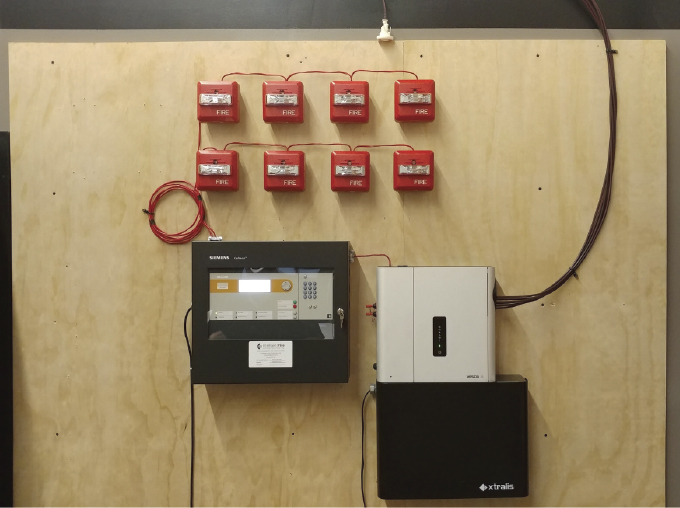Before the Patriots could take on the Rams in the Super Bowl, ensuring the safety of assigned broadcast personnel and equipment was required at the Georgia World Congress Center Authority (GWCCA) convention center. Like other facilities located near the Mercedes-Benz Stadium in Atlanta, Georgia, the convention center was being used to accommodate the immense surplus of support personnel and equipment associated with the event.
When global events like these come to town, temporary facilities are often required to accommodate specialized equipment and support personnel. In the case of the GWCCA convention center, this meant building temporary offices within a large hall to accommodate essential broadcast support equipment and personnel. The offices included a broadcast control room, a room for storing engineering equipment, and a meeting area.
COMPLIANT SPACE NEEDED
Despite being a temporary solution, the newly constructed office space had to remain compliant with fire codes. This essentially meant that a complete fire detection system had to be installed and later removed.
Installing a “temporary” fire detection system is no small feat, however. Although traditional spot smoke detectors are easy to install, it requires certified electricians to run electrical conduit and wire to each unit that connect back to a central alarm panel.
Although the GWCCA convention center had its own traditional fire detection system, the decision was made to install a complete, standalone system including fire alarm panel.
“They were not going to accept the existing Convention Center’s Fire Alarm System on its own,” says Christian Santamaria, a co-founder of Intelligent Fire Systems & Solutions, Inc., a fire and life safety installation company involved with the project. “They wanted additional protection for the temporary structure within the convention center that was completely separate from the existing system so it could be installed quickly and removed with ease after the event was over.”
FIRE MARSHAL RECOMMENDED
According to Santamaria, the fire marshal specifically recommended an advanced aspirating smoke detection system for the application.
For the project, an aspirating smoke detection system called the VESDA-E VEA from Xtralis was selected.
The VEA unit draws air in through tubing connected to small, unobtrusive “sampling points” located in each room. The air is analyzed to identify the presence of minute smoke particles in a continuous process using sophisticated laser-based technology built into the central unit.
The system is able to detect minor particles in the air much faster than traditional spot smoke detectors, even before a fire begins to flame and burn. In many cases, early warnings can speed evacuation and prevent fire spreading to other areas.
The technology, though advanced, is not new. Aspirating smoke detection technology has been used for decades in sensitive applications such as cleanrooms and data centers where early smoke detection is critical.
THE RIGHT SOLUTION
Although the VEA system is often installed as a permanent solution, the ease of installation makes it ideal for operational smoke detection in temporary facilities or during construction or remodeling of any space. The VEA has already been installed for this purpose in schools, universities, hospitals, and medical office buildings.
According to Santamaria, the VEA detector used for the GWCCA convention center application utilized six smoke detection sampling points, although a single detector allows for up to 40. He notes that the fire marshal specified that audible/visible alarms had to be installed inside and outside the temporary offices as well.

One of the most helpful factors in this project, was the simplicity of the VEA system compared to traditional methods, which usually involve running electrical wire and conduit.
“Depending on the size of the rooms, it can easily take a couple of days just to run electrical wire and conduit between rooms, which adds to cost and complicates removal,” says Santamaria.
In contrast, the aspirating smoke detection system does not require a certified electrician to run the small, flexible tubes to the designated locations. The central unit also simplifies testing and monitoring of the system.
QUICK TURNAROUND
To speed installation, Intelligent Fire Systems & Solutions Inc. pre-fabricated and programmed the VEA aspirating system before it was shipped to Atlanta. “We also created a video to demonstrate how to install and test the system for the installation team onsite,” explains Santamaria.
Although he was on standby to fly to the location if needed, the installation team was able to successfully install the system without difficulty. Once installed, the fire marshal quickly inspected and approved the system.
CONCLUSION
Since it was implemented as a standalone system and without running electrical wiring, the system was easy to remove. Although it is not determined yet, it could be utilized at other events that may have temporary structures which require a fire alarm system.
“Because the aspirating smoke detection system is not tied into the facility’s electrical or fire detection systems of the convention center, it is easier to remove and reuse in different configurations and even with more sampling points if needed in the future,” explains Santamaria. “That kind of flexibility is the reason the VESDA-E VEA system works so well as an economical, temporary solution for events requiring supplemental smoke detection.”
FOR MORE INFORMATION
For more information about Xtralis, call 619.252.2015, email sales@xtralis.com, or visit www.xtralis.com/vea.
Modern Contractor Solutions, May 2019
Did you enjoy this article?
Subscribe to the FREE Digital Edition of Modern Contractor Solutions magazine.



